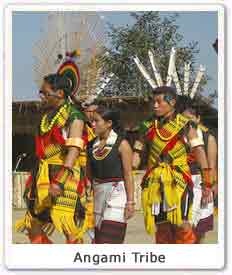Angami tribe belongs to the extreme north eastern part of the country, in the state of Nagaland. Nagaland is made up up of 20 tribes and Angami is one of the them.
Language and Clothing :
Tenyidie is the most common language spoken anong the Angamis in Nagaland. The total population of the Angamis is around 12 million. Agriculture is the main occupation. They cultivate rice and grains on the hilly terrains.The design of the clothes worn by the Angami men and women are quite different from each other. Men wear shawls called white Mhoushu and the black Lohe. The women wear Mechala - the wrap around skirt and shawls of unique designs and patterns. Both men and women enjoy wearing beautiful ornaments. Beads, miniature mask pendants, bangles and bracelets are most common among them all.

Religion :
Christianity is the major religion followed among the Angami tribal people. Their religious system revolves around several supernatural forces of life associated with the life cycles. They regard several objects as embodied spirits and have sharply drawn the distinction between the Gods and the soul of the human bodies. They are the firm followers of Ayepi (who bring peace and prosperity in their lives).
Art and Craft Culture :
Angamis are quite popular for their woodcraft and artwork. People all India know them as the as the producer of bamboo work, cane furniture, beds, shawls and powerful machetes. Angamis play great music with the help of drum and flute, which is passed on from one generation to the other. The simple and rythmic music plays the important role in their rituals and festivals. Traditional dancing is the main component in Angami gennas. Angami women also practice pottery at their houses. They re expert basket makers. Pork with bamboo shoot is the common dish among the Angamis.
Festivals :
Sekrenyi is the main festival celebrated among the Angamis in Nagaland. The festival falls in the month of February and marks the beginning of the lunar year. This ten day festival is also known as the Phousnyi among the locals people. The foremost ritual of the festival is Kizie, in which the few drops of the rice water taken from Zumho (top of the Jug), are carefully put into the leaves and placed at three main points of the post of the house by a women. Next morning all the young men of the village get up early in the morning and take a bath in the village well. They adorn themselves with the new shawls (white Mhoushu and the black Lohe). This ceremony is known as Dzuseva. The main attraction of the festival is the Thekra Hie, where the young ones of the village gather all together to sing and dance to the tunes of the traditional music. The participants make fun and enjoy themselves with the rice bear and plates of meat. Haunting is the another important excitement of the festival. The major part of the ceremony falls on the eighth day when the gate pulling or the bri9de pulling is performed.






